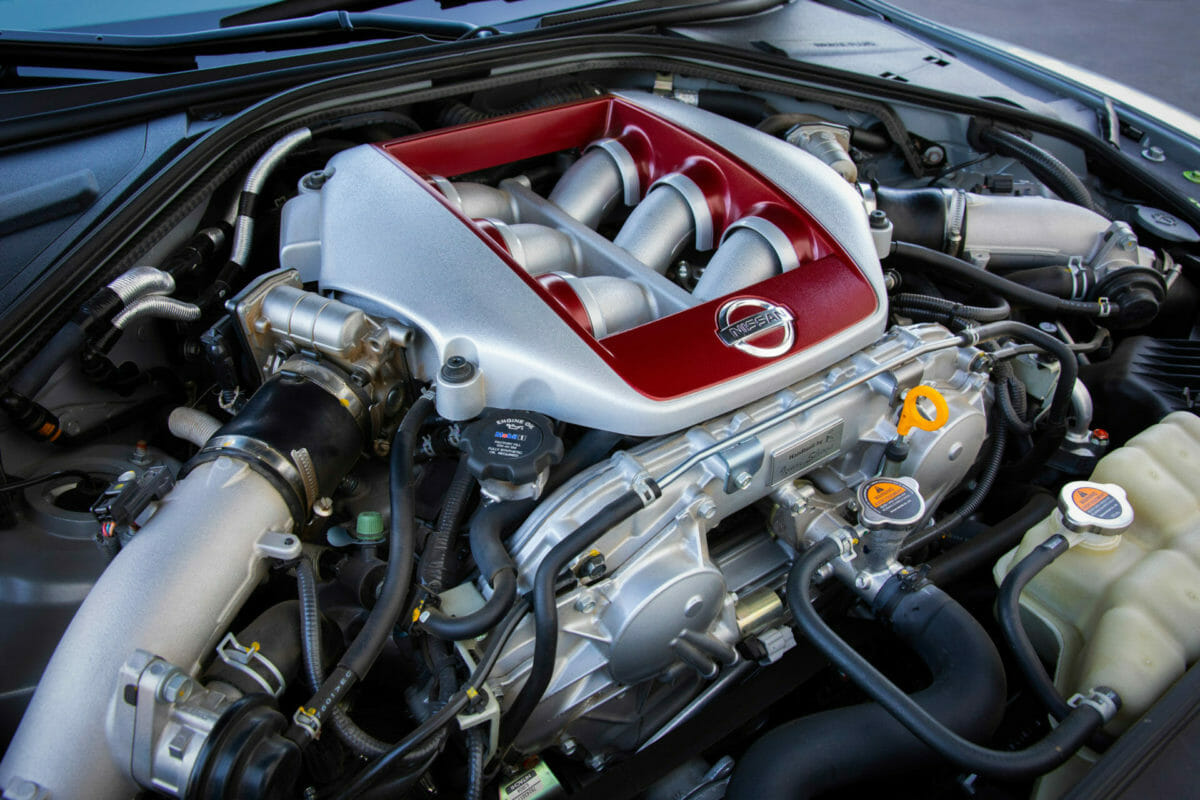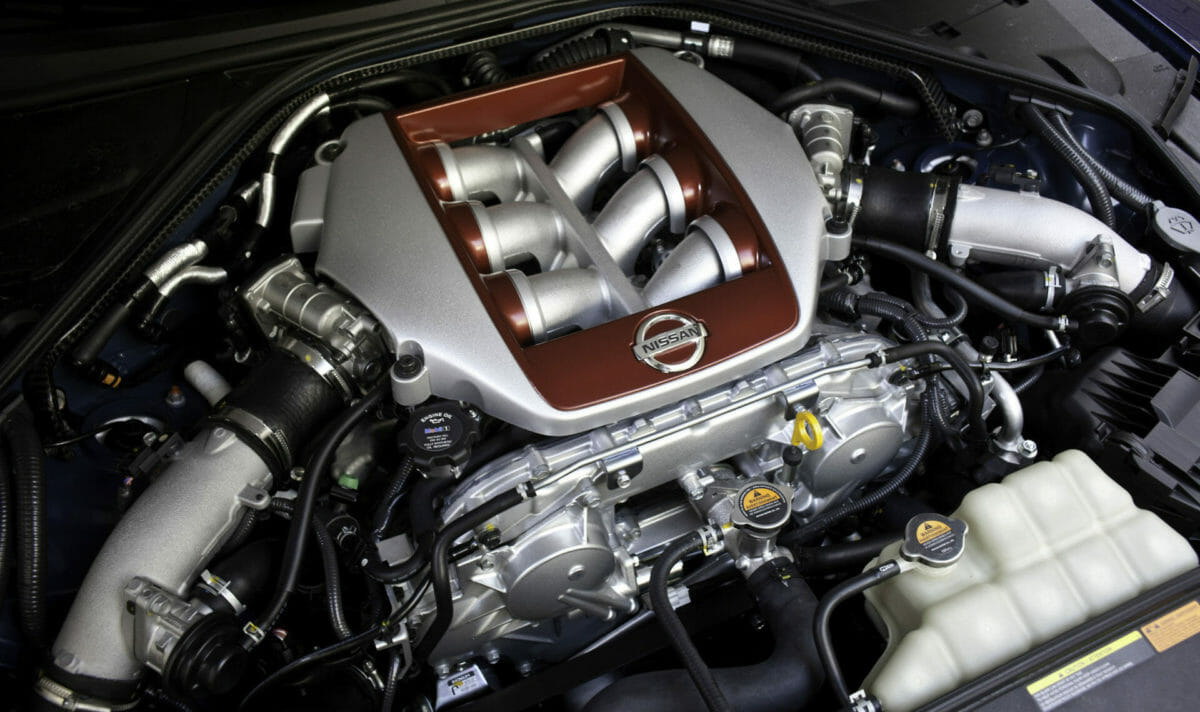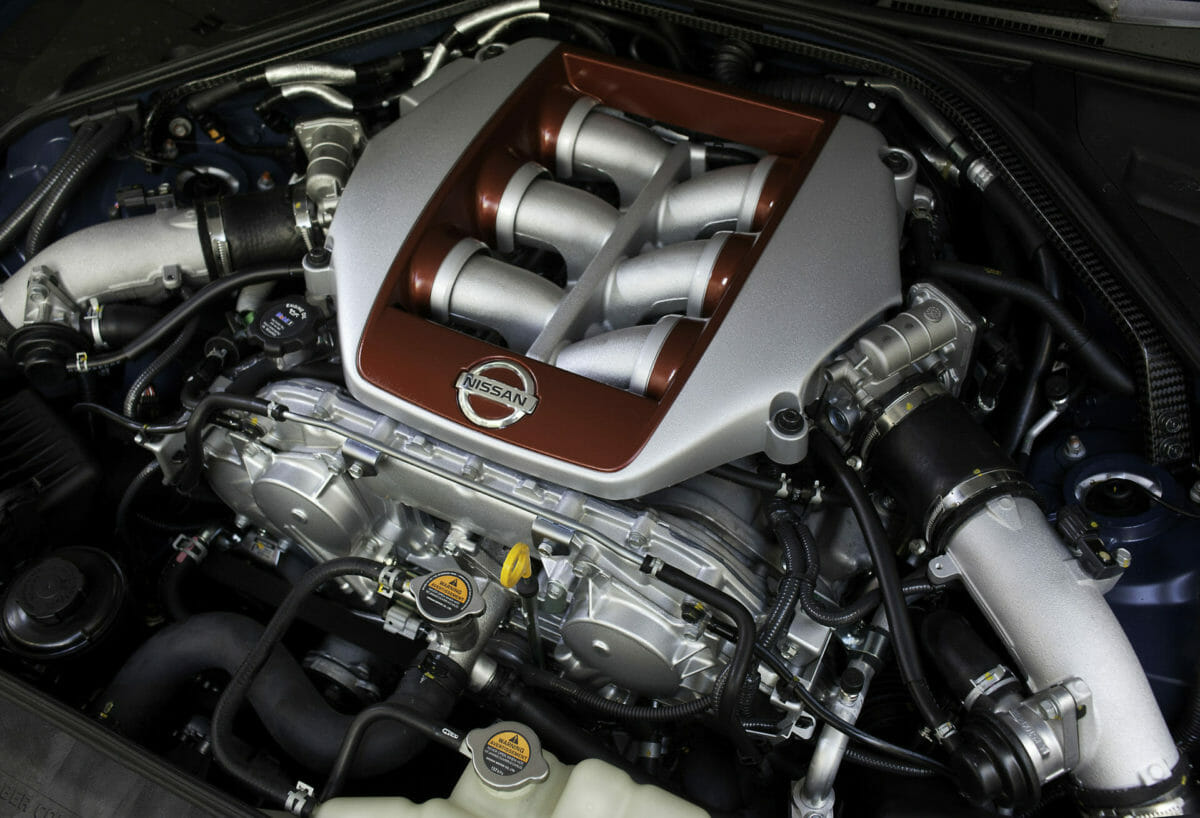The ferocious twin-turbocharged V6 engine that powers the Nissan GT-R is a beautiful staple of art and engineering. It pays to know what you’re getting under the hood.

The Nissan GT-R is a high-performance sports car with a monumental engineering aspect behind every aspect of its design. It first debuted in the U.S. for the 2009 model year. It immediately grew a devout fanbase and following due to its high-performance characteristics at a fraction of the price of its exotic counterparts like Ferrari and Lamborghini.
While the current generation of the GT-R, the R35 chassis, is the first time the GT-R nomenclature became available in the U.S., it fills a massive shoe carrying on the heritage of past GT-Rs.
The GT-R started as a performance trim level of the 1969 Nissan Skyline “Hakosuka” and remained available until 1971. The 1973 Nissan Skyline GT-R is considered the second generation of the GT-R nomenclature and was only available as a coupe and only for the 1973 model year. After this, the GT-R name would remain retired until the fearsome R32 Skyline GT-R’s debut in 1989.
The R32’s twin-turbocharged inline six-cylinder engine and all-wheel-drive system earned it the nickname “Godzilla” when competing in Australia due to its Japanese origin and its fearsome domination on the racetrack.
The GT-R remained a twin-turbo inline six-cylinder all-wheel-drive performance car through the R33 generation (1995-1998) until its discontinuation in 2002 during the R34 Nissan Skyline. The GT-R name would remain on hiatus until introducing the R35 Nissan GT-R at the 2007 Tokyo Motor Show.
Though the R35 GT-R shares the continuation of the Skyline chassis codes, it is not a Nissan Skyline. However, it lives up to its ancestors’ high-performance heritage and racetrack dominance thanks to its remarkable twin-turbocharged V6 engine. We’re going to give you an overview of the specs, history, and variants of the engine found under the hood of the R35 Nissan GT-R since its release.

What are the R35 Twin-turbo V6 Specs?
The engine found in the R35 GT-R is called the VR38DETT. While the numbers and letters can be a bit off-putting, it’s easy to understand what they mean with some context.
“VR” is the family of engines this engine comes from. There are also VR engines in other Nissan and Infiniti products. The number 38 refers to its 3.8-liter displacement. The letter D represents its dual overhead camshaft layout. Furthermore, the letter E indicates it has electronic fuel injection. Finally, the letters TT indicate that it is twin-turbocharged.
Both the engine block and cylinder heads of the VR38DETT are made of aluminum. The cylinder bores have a plasma-sprayed liner to increase their durability. The Nissan GT-R engine is equipped with forged steel rods and a one-piece, forged steel crankshaft from the factory. This makes the internal components of this engine incredibly strong and resilient. There is a multitude of examples of this engine making extreme horsepower without internal modifications. Furthermore, there are many examples of these engines lasting high into the 100,000-mile range.
The VR38DETT has a compression ratio of nine to one. Additionally, it has a bit of an exotic firing order compared to many V6s. It has a sequential firing order, meaning the cylinders fire in order from one to six. It has a 95.5-millimeter cylinder bore and an 88.4-millimeter stroke.
One of the most interesting aspects of the Nissan GT-R engine is that every single one is hand-built by one of only four Nissan employees. They are the best and most experienced engine craftsman that Nissan has on their payroll. They are known as Takumi, which means someone who has mastered their profession to a level of perfection. Each engine has a plaque bearing the builder’s name and signature.

Nissan GT-R Engine Power & Variations
Since its release, the R35 GT-R and its engine have undergone a few changes that steadily increased the power output. Over the years, upgrades and advancements in technology have allowed Nissan and their performance division, Nismo, to squeeze extra power out of the engine without compromising its reliability and daily usability.
The 2009 Nissan GT-R came with a substantial power output of 480 horsepower and 430 lb.-ft. of torque. However, this figure would continue to climb over the years.
The 2010 model year saw minor tweaking and pushed the power up just a hair. Both the 2010 and 2011 Nissan GT-R came with 485 horsepower and 434 lb.-ft. of torque.
The first major power jump came in the 2012 Nissan GT-R with revisions to the engine computer maps and changes in the valve timing via the engine’s active variable valve timing system. These modifications resulted in an impressive jump to 530 horsepower and 448 lb.-ft. of torque.
The 2013 Nissan GT-R again saw a power increase that would remain the same through the 2016 model year. These models have a power output of 545 horsepower and 463 lb.-ft. of torque.
Finally, the 2017 model year brought a complete facelift as well as yet another power increase. This variant of the GT-R and its engine is still currently available through the 2021 model year. It has an impressive power output of 565 horsepower and 467 lb.-ft. of torque.
There are also several special edition variants of the Nissan GT-R with varying engine power outputs. The most substantial of which is the GT-R Nismo. Tuned by Nissan’s motorsports performance division, the Nismo GT-R is available in the 2014 and 2020 model years. Both have a power output of 600 horsepower and 481 lb.-ft. of torque.

What is the GT-R Engine’s Longevity & Fuel Economy?
Though a high-performance engine is not generally intended to be used for daily driving, the Nissan GT-R engine happens to be pretty decent on gas. There are many people that use R35 GT-Rs as daily drivers. Is daily driving an R35 feasible when it comes to wallet survival? Let’s take a look at the fuel economy performance of the Nissan GT-R.
The fuel economy ratings from the EPA may surprise you a bit, considering the substantial power output of the GT-R’s engine. However, earlier GT-Rs have a remarkably decent fuel economy rating of 15 mpg city and 21 mpg highway.
Furthermore, the newest GT-R model has EPA ratings of 16 mpg city and 22 mpg highway. While these numbers aren’t substantial compared to a modern economy and hybrid cars, they are very impressive compared to performance vehicles of a similar nature.
The longevity of performance car engines is also something to be concerned with. Often, you’ll find that performance sports cars generally have fairly low mileage.
However, the GT-R is a bit of an exception, with many people using them as daily drivers. It is not uncommon to find older generation GT-Rs with upwards of 100,000 miles on them that are still running great.
Overall, while the VR38DETT is not built to be used every day, it certainly can be. The R35 GT-R has four seats and a sizable trunk. Combining these features with the dutiful reliability of its impressively powerful engine makes it relatively feasible as everything from a grocery-getter to a weekend racetrack weapon.

Performance Applications
The VR38DETT is a common engine of choice for many performance applications. The GT-R is a prevalent choice in drag racing as its resilient engine combined with its world-class all-wheel-drive system make it a fierce competitor in a straight line.
However, the GT-R’s design intent was to create a car that handles well in the corners.
As a result, you’ll find it hard to make an appearance at a racetrack of any sort without seeing the versatile GT-R in attendance. There are a few outstanding examples of the use of VR38DETTs in extreme performance applications.
Alpha is a company that is notorious for its extreme performance Nissan GT-Rs. Their most notable example is a drag racing GT-R with a mind-blowing 3,400 horsepower. Though the engine is extremely modified, it is still a GT-R VR38DETT as its starting point. This insane vehicle is capable of running six-second quarter miles at over 200 miles per hour.
Another outstanding example of the use of a VR38DETT is not in a GT-R chassis. Instead, it is under the hood of Formula Drift pro driver Kazuya Taguchi’s Nissan Silvia drift car. It is bored and stroked to 4.1-liters and makes over 1,000 horsepower. Like all drift engines, Taguchi’s VR38DETT engine is relentlessly abused every time it sees a track.
Perhaps the most exotic use of the Nissan GT-R engine was Nissan’s own use when they put it in the controversial Nissan Juke. The Nissan Juke R features the same 545 horsepower VR38DETT found in the GT-R.
Additionally, a second edition Juke R with the 600 horsepower Nismo GT-R engine has been a rumor floating around for several years.

Nissan GT-R Engine’s Performance & Usability
Whether you are looking for a fun daily driver to take to track days on the weekend or you want to start your next drag-racing project, the Nissan GT-R engine is an engine you can depend on for success.
If you are considering a unique swap for a drag or drift car, the VR38DETT can make a great starting point that has a nearly endless supply of aftermarket parts to achieve your goals.
A used Nissan GT-R in good shape is relatively easy to find for around $50,000 for an older model. As always, be sure to inspect a vehicle’s VIN using our free research tool to be sure you’re getting the car you want.
If you’re shopping for a brand-new model, the base price starts at $113,540 for a 2021 model. While it isn’t the most affordable sports car on the market, it does offer mind-blowing performance for the price.
Photos: Nissan
